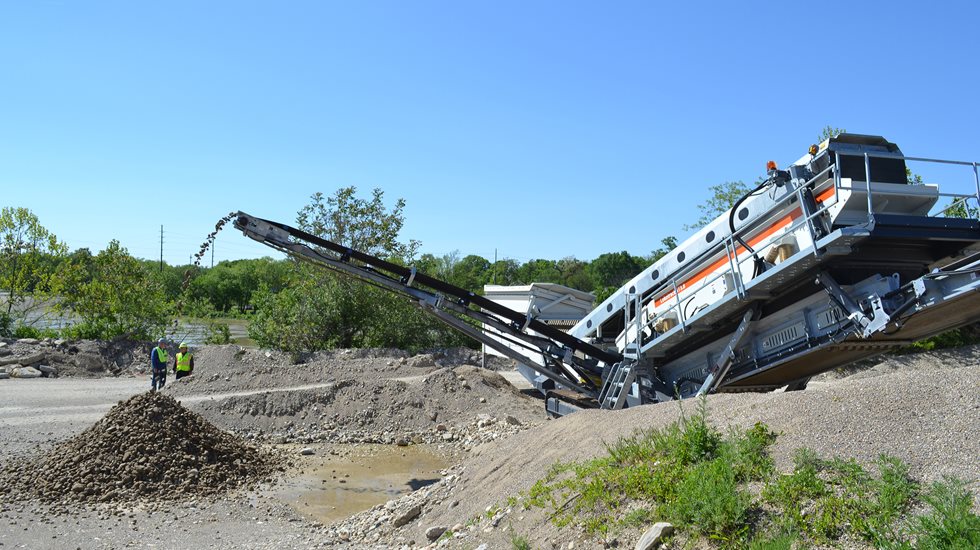Glacial outwash
At one time, glaciers up to a mile thick covered two-thirds of the state of Ohio. When the last ice age in North America ended around 10,000 years ago, the receding glaciers left behind large deposits of highly permeable sand and gravel, known as glacial outwash. Today, the Great Miami River transports a large amount of this outwash and deposits it where flow conditions change, including in the slower currents running through the city of Hamilton.
The local water authority contracts with Welch Sand & Gravel to remove outwash from a 15-acre section of the river in Hamilton. Welch is only allowed to excavate to a depth of 3-4 feet, to prevent the outwash from moving further downstream and to keep the summer pool area open. The popular pool is used by the local community for recreational activities including fishing, boating, canoeing, and other water sports.
Welch operates the Metso Lokotrack ST3.8 mobile screen at the Black Street Bridge site in Hamilton, where the company has a seasonal permit allowing them to mine river gravel from March through December. They have had the permit for this work since 2004, and the amount of material removed each year varies depending on the weather. “We have done as much as 119,000 tons, with an average of 50-78,000 tons out of the Great Miami River operation,” says Rick Goessling. “It all depends on the amount of rainfall and flooding that takes place.”
Efficiency with new screen
The new ST3.8 mobile screen replaces an older model Metso ST356 screen in operation since 2006. “We ran that ST356 mobile plant for about 10-11 years, and we wore it out,” says Production Manager Rick Goessling, who has been with the company since 1981. “We ran millions of tons of gravel through that thing,” he added, “and we just decided it was time to update, so we called Process Machinery.” Process Machinery, Inc. (PMI) is Metso’s distributor in the states of Ohio, Kentucky, and Indiana. After conferring with PMI Senior Sales Manager Gary Honchell, Welch Sand & Gravel decided to purchase the new Lokotrack ST3.8 screen.
“Our customers want equipment that will last,” says Honchell. “Metso’s new mobile screens are not only built sturdier, but most of the key parts are galvanized for longer life at no additional cost.”
One-stop process
The mining process at Black Street Bridge is a one-stop operation. Welch operators use a hydraulic excavator to remove material from the river and transport it by truck to the Black Street Bridge site. The wet river gravel is dumped on the ground and allowed to dry for 24 hours (or until it becomes workable), and then processed through the Lokotrack ST3.8 mobile screen. Any material pulled from the river becomes Welch’s responsibility to either process or properly dispose of in accordance with strict environmental regulations. This includes everything from tree branches to old tires and general river debris.
On average, Welch Sand & Gravel processes 1,500-2,000 tons per day of outwash material through the ST3.8. The screening plant combines an 18-ft x 5-ft. double-deck screen with an advanced process control system and fuel-efficient engine package. Welch produces 1½ʺ minus product from the top screen deck, and everything from 3/8ʺ pea gravel all the way down to sand from the second deck. “The ST3.8 is a great choice for medium- to large-scale operations,” says Scott Yablonsky, Metso Distributor Manager, Atlantic USA. “With the double-deck design, customers can produce and sort up to three different sized end products.”
“So far we are very happy with the ST3.8,” says Goessling, “and how fast we can move it, set up, and run. There have been some great changes that make it so much more user friendly, and I think it will do a great job for us.” He also speaks highly of the support provided by the team at Process Machinery. “They have always been very professional, willing to teach or show new products, and they are proud of representing Metso equipment.” Most importantly, the new mobile screen helps Welch Sand & Gravel keep their commitment to the local community. As Rick Goessling puts it, “Metso, Gary Honchell, and Process Machinery help us fulfill our obligations and continue our positive relationship with the city of Hamilton, Ohio.”
About Welch Sand & Gravel
Welch Sand & Gravel, Inc. is a 50-year old family owned company serving the greater Cincinnati, Ohio region, including portions of Indiana and Kentucky. The company was founded by Charlie Welch (over 90 years old) and is currently under management of sons Jim and Ron Welch, both company vice presidents. Welch’s aggregate products are widely used by concrete and asphalt producers as well as by private and public contractors. The company has grown to consistently rank in the top ten of Ohio’s largest sand & gravel producers.
